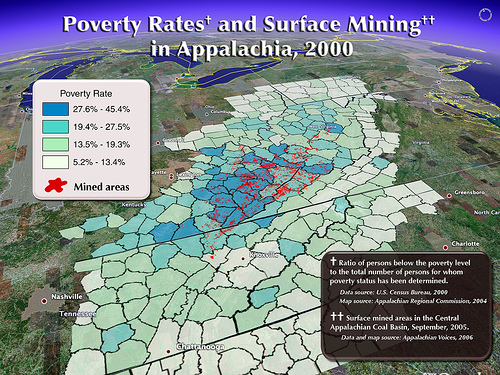I talk a lot about renewable energy and jobs. Mostly because I grew up in the midwest, and saw first hand what a “transition” to a new system can do to an intrenched industry. When the Japanese, Korean and European car companies started making better more efficient cars in the 80’s the midwest “transitioned” from the Bible belt, to the rust belt. Thousands of people lost jobs as factories closed and plants moved to Mexico and overseas. Well welcome to the new transition, carbon is out, renewable is on it’s way in.
In the 80’s 90’s and now in the 00’s American industry has for the most part been content to let these new jobs go to others. We stubbornly plod along thinking that we can keep doing things “our” way while Europe and Asia retool for the next century. The next industry up for gutting is the coal industry. Luckily a transition to renewable energy sources promises significant global job gains at a time when the coal industry has been hemorrhaging jobs for years, according to the latest Vital Signs Update released by the Worldwatch Institute.
The coal, oil, and natural gas industries require steadily fewer jobs as high-cost production equipment takes the place of human capital. Why pay ten guys with pick axes to go into a mine when you can pay one with a fancy coal robot? Many hundreds of thousands of coal mining jobs have been shed in China, the United States, Germany, the United Kingdom, and South Africa during the last two decades, sometimes in the face of expanding production. In the United States alone, coal industry employment has fallen by half in the last 20 years, despite a one-third increase in production. These jobs are often lost in areas that have been in brutal poverty for years. It seems that even when coal companies provided jobs, they provided low paying dangerous ones. Now that they are leaving, the poverty only gets worse, and the people are left with a mined out waste land to be poor in. Coal has rapped these communities for everything they are worth and then moved on.

“Renewables are poised to tackle our energy crisis and create millions of new jobs worldwide,†according to Worldwatch Senior Researcher Michael Renner. “Meanwhile, fossil fuel jobs are increasingly becoming fossils themselves, as coal mining communities and others worry about their livelihoods.”
Strong government support has allowed Germany, Spain, and Denmark to emerge as leaders in renewable energy development—and green jobs. The German government reports that the country was home to an estimated 259,000 direct and indirect jobs in the renewables sector in 2006. This figure is expected to reach 400,000–500,000 by 2020, and 710,000 by 2030. In the United States, the renewables sector employed close to 200,000 people directly and 246,000 indirectly in 2006, due mostly to leadership at the state level, rather than strong leadership at a federal level. China is rapidly catching up in manufacturing of solar photovoltaics (PV) and wind turbines and is already the dominant global force in solar hot water development.
An estimated 2.3 million people worldwide currently work either directly in renewables or indirectly in supplier industries. The solar thermal industry employs at least 624,000 people, the wind power industry 300,000, and the solar PV industry 170,000. More than 1 million people work in the biomass and biofuels sector, while small-scale hydropower employs 39,000 individuals and geothermal employs 25,000.
These figures are expected to swell substantially as private investment and government support for alternative energy sources grow. The most optimistic analyses project that global wind power employment will increase to as much as 2.1 million in 2030 and 2.8 million in 2050. Similar projections estimate that worldwide solar PV production alone could create as many as 6.3 million jobs by 2030.
“Government officials now have yet another reason to put the full weight of their support behind renewables,†said Renner. “In addition to protecting our planet and phasing out an increasingly limited resource, policies that support renewable energy also support job creation.”
The real question here is how many of those 9.1 million potential jobs will be in the US? My feeling is that because we are so far behind it would take a significant increase in government (federal, state and local) support as well as a shift in culture to grab a majority of these jobs. But the demand is there, and America does has a lot going for it. We have a well educated work force with good transportation infrastructure. We have high tech science and one of the worlds best university system for R & D. And we have all the money. These jobs could be just the thing that gets us out of our troubled economic problems. Lets hope the next industrial revolution in this country will be a green one.
If you are looking for a job in renewable energy be sure to check out our renewable energy job search box (below or on the right over there), as well as checking out The Sietch’s guide to renewable energy jobs here.
One thought on “Renewable Energy Generates Job While Big Carbon Generates Pink Slips”
Comments are closed.